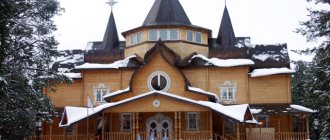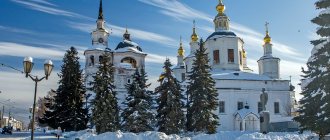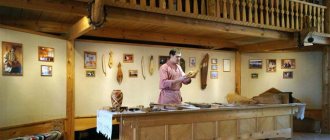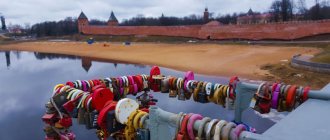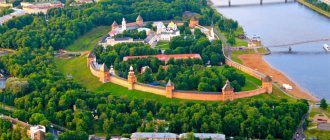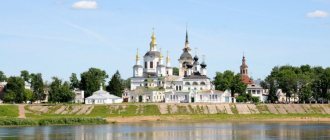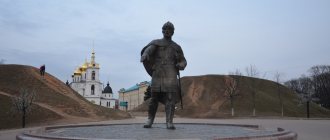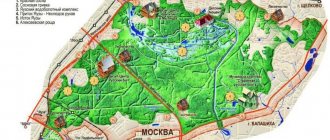Today Veliky Ustyug is known primarily as the birthplace of Father Frost. And the majority of tourists, and there are no less than three hundred thousand of them here a year, come here precisely for the residence of this kind fairy-tale wizard. The latter is located about ten kilometers from the city, so not everyone gets to Veliky Ustyug. Yes, so be it: the tourist flow is growing, the infrastructure is developing, jobs are being created - good!
The most amazing thing in this whole story is that Veliky Ustyug is beautiful without Santa Claus. The city has a rich historical past, it is beautiful and interesting. But the main thing is that entire blocks of pre-revolutionary regular buildings have been almost perfectly preserved here. Merchant mansions, which are one hundred or two hundred years old, stand in neat rows like ancient Russian heroes. And these ranks have not thinned out over time; they are not only in order, but also not interspersed with inappropriate buildings of later eras. It is precisely this architectural homogeneity that makes Veliky Ustyug especially valuable. This is definitely one of the most pleasant discoveries of this year: a city from which you absolutely don’t want to leave, and then really want to return there.
We were traveling from Totma to Veliky Ustyug. My phone rang. I turned on speakerphone.
- Hello, this is Love from the estate of Santa Claus. Are you coming soon? We are waiting for you!..
At that moment it seemed to me that we were in a fairy tale. Love turned out to be the press secretary of Santa Claus, but the anticipation of a quick meeting with good magic from this fact only intensified.
Father Frost's estate
Twenty years ago in Veliky Ustyug no one had even heard of Father Frost: previously no one had given much thought to the geographical habitat of this fabulous old man, and old fairy tales shed no light on this matter at all. The project “Veliky Ustyug - the birthplace of Father Frost” was invented in the crisis year of 1998 by the then mayor of Moscow Yuri Luzhkov. While passing through the nearby village of Morozovitsa, he asked: “Why Morozovitsa? Isn’t this the birthplace of Father Frost?”
In December of the following year, at the recreation center of the Novatorsky timber industry enterprise, Father Frost received the first guests in his new mansion. Rumor has it that the first “grandfather” was a former electrician from that same timber industry enterprise.
Twenty years have passed. Now the patrimony of Father Frost is a huge tourist complex. There seems to be everything here: a blacksmith shop, a carpentry workshop, a zoo, a greenhouse, and even a forest pharmacy (apparently, in case someone suddenly gets sick - a child from the abundance of entertainment, or his parent from the amount of money spent).
The heart of the complex is the huge tower of Father Frost. Next to it, as the main holiday tree, is a plastic cone decorated with garlands. At this very moment the fairy tale begins to burst at the seams.
The inside of the tower: scary boxes of white split systems and a wall rotted from the flowing water.
The fairy tale is over, welcome to the real world!
You can stay on the territory of the estate in a hotel or in separate cottages. There is also a restaurant, several cafes and a cheese factory where they produce Ragusanio, filotti and other caciotta. Prices for local cheese, by the way, are very reasonable: in the range of 600-700 rubles per kilogram, which is quite comparable to what we usually sell under the guise of cheese in chain stores.
Thanks to our hotel partner TVIL.RU, we lived in one of the separate cottages. It belonged to a tourist company.
The cottage consisted of two floors: several bedrooms, a spacious kitchen-dining room and a basement in which billiards and table tennis tables were hidden. I spent a good half of the night behind one of them, actively swinging my racket.
In one of the rooms there was a modest sign hanging on the wall.
A fabulous morning arrived and we, having loaded ourselves with absolutely fabulous sandwiches, went to meet Santa Claus.
The path to becoming a wizard is not easy.
First, you need to walk along the “Trail of Fairy Tales”: chat with fairy-tale characters, dance, complete a number of competitions and solve a number of riddles.
Whether long or short, all the tasks were completed, and we found ourselves in front of the tower.
Now we had to visit all his rooms, and there are twelve of them, and get acquainted with the old man’s personal belongings - pillows, fur coats, books and a newfangled selfie stick. In the process, we learned that Santa Claus has his own coat of arms and standard, and that in the mansion you can even hold a ceremony for the newlyweds (the wedding night is not included in the list of entertainment).
The last test was waiting in line. Time fled. The line didn't move.
Finally, we were invited. Santa Claus turned out to be a two-meter giant with tired eyes.
We quickly exchanged a few words with him, took a photo, after which grandfather conveyed his warm greetings to the Belarusian Dzed Maroz and the Finnish Joulupukki, whom I had met earlier.
We went to have tea. The head of the Veliky Ustyug region, Alexander Kuzmin, came to greet the members of the expedition. Santa Claus treated us to honey and pine cone jam and lamented: “You upset me that you came without a family and without children.” After all, our families are our most precious, greatest wealth. Take care of your family and friends, never call on the phone, but visit each other.
In response, I said that I was also upset: plastic cones instead of live Christmas trees are no good! Santa Claus promised me that someday a real fluffy spruce would grow next to the tower, and I promised to come with my family next time. That’s what they decided on (the author of the photo with the tea party is Sasha Safronov).
Finally, Santa Claus threw out Balabanov’s “Well, if you love honey, love the cold!”, tapped his staff, adjusted his crown and went outside to communicate with the children who had come to visit him.
And we went to the glacier to look at “all the beauty of the sparkling north” collected there.
What can I say: the patrimony of Father Frost is an excellent example of how to create tourism brands from scratch. The entire history of the development of this project is an adventure in its purest form, on the one hand, and a consequence of the periodic presence of political will, on the other.
The transport accessibility of Veliky Ustyug in 1999 was practically zero: the construction of a bridge across the Northern Dvina, through which you can now easily get to Kotlas, was then virtually frozen, the road from Vologda was in extremely poor condition, and the local airport was breathing its last, receiving only a couple of flights a week. In fact, it was possible to get to the city only by rail: in a trailer car to the Moscow-Vorkuta train, for which it was not so easy to get tickets, or by train, which at that time connected Veliky Ustyug with Yadrikha railway station on the route "Vologda - Kotlas".
Nowadays, there are roads - the journey from Kotlas takes no more than an hour, and from Vologda - no more than five; and they promise to reconstruct the airport by next fall; and in winter, special tourist trains run from St. Petersburg and Moscow to the estate of Father Frost.
If in 1999 no more than two thousand tourists visited Veliky Ustyug, then in 2021 - already more than three hundred thousand. And 99% of this is precisely the merit of the estate. It seems that this is success.
But this coin also has a flip side: the artificially synthesized patrimony of Father Frost in ancient Veliky Ustyug is like a plastic double-glazed window in a hundred-year-old wooden merchant’s house: the result seems to be there, but if you look more closely, everything is somehow wrong. This project is exclusively about money, this is clear from the first minute. And the magic here is like in a shopping center: humming air conditioners on the walls and boorish two-meter-tall security guards driving children away from the old man in his mansion. Like that will do. But when the patrimony was just in its infancy, any child could call from home in Veliky Ustyug in the evening and personally talk to Santa Claus...
— Adult bloggers have arrived here, give them a fairy tale. What's wrong with artificial Christmas trees? Here on Palace Square in St. Petersburg - also before the New Year, a plastic cone is installed...
The bad thing about this story is that there is no sincerity in it: the patrimony of Santa Claus is a conveyor belt for pumping out money, which, by the way, works almost perfectly. To the question - what prevents us from doing everything really well, with attention to detail, the project is all-Russian, and there is clearly money here - there is no answer.
Finally, I cannot help but say that behind the scenes of the estate, Shakespearean passions have been in full swing for many years: the tourist center is quite a tasty morsel, and there is a real struggle for its possession. This year, this story reached its climax: the old team was fired, and the complex got a new owner. According to the official version, all these changes are related to improving the management system and optimizing costs; according to local residents, this is a regular raider takeover.
The development plans of the new owners are truly Napoleonic: over the next five years, an amusement park, a cinema, a water park and a spa complex should appear on the territory of the estate. Maybe they will finally plant a real Christmas tree.
Zoo
Father Frost in Veliky Ustyug became the host not only of the New Year, but also of a branch of the Moscow Zoo. It is directly adjacent to the estate and is located on the picturesque bank of the Sukhona River. The zoo opened its doors in 2009, its area is about 7.5 hectares. The first to settle here were bear cubs with colorful names - Masha and Misha. Zoo workers had to feed them themselves, because their mother was killed by poachers. A little later, the company of bear cubs was diluted by the wolf Fang and the fox Alice.
Today, the Zoo is home to 250 mammals and 136 birds.
Of these, several species are listed in the Red Book of the Russian Federation:
- dappled deer;
- reindeer;
- dry nose;
- mountain goose;
- barnacle goose;
- steppe eagle;
- Japanese crane.
See also: Amazing animals of the Red Book for children
A trip to visit Santa Claus can be a real event for children of all ages. After all, the Zoo has 2 areas where visitors are allowed to feed and even pet animals and birds.
Veliky Ustyug
Veliky Ustyug, as opposed to a fiefdom, is alive and sincere.
Our acquaintance with him began in Dymkovskaya Sloboda. In the past - a village, then - a settlement, and now - a district of the city, located on the opposite bank of the Sukhona from the historical center. It is interesting that Kirov, which is not so far from Veliky Ustyug, also has its own Dymkovskaya Sloboda. Located according to the same principle - on the opposite bank of the Vyatka from the city - the “Kirov” Dymkovo settlement is the birthplace of the Dymkovo toy.
Veliky Ustyug Dymkovskaya Sloboda is famous for its churches. It is believed that the first temples appeared on this site around 1380 - in honor of the victory of the Russian army in the Battle of Kulikovo. All this happened a long time ago, and in general it’s not accurate: there are no traces or reliable mentions left of those ancient temples. The churches that have survived to this day - Dmitry Thessalonica and Sergius of Radonezh - were built at the beginning of the 18th century.
The embankment in Dymkovskaya Sloboda offers the best view of the historical center of the city. In winter, you can cross the river on ice; in summer, locals are accustomed to crossing it by boat (although there is a road bridge a couple of kilometers upstream).
The heart of Veliky Ustyug is the Cathedral Courtyard. Its architectural complex includes the Assumption Cathedral, the bishop's house and five more churches, but from this shore they all look like a single complex structure.
A hundred years ago there were about thirty temples in the city. Less than half of them survived Soviet times, but even now the number of domes towering over the city's rooftops is astonishing.
Veliky Ustyug greets guests with hand-drawn posters. In my experience, this is one of the first signs that a city is extremely interesting.
The history of these places dates back to the 13th century. Then, on a high mountain several kilometers from the modern city, the Rostov-Suzdal princes founded the settlement of Gleden (in the original - Glyaden - since it was convenient to “look around” all the surroundings from the fortification). Now the village of Morozovitsa is located there, the same one where the Moscow mayor came up with the idea about the “homeland” of Father Frost. The memory of the historical name of this land is preserved by the now inactive Trinity-Gledensky Monastery.
The settlement of Gleden, soon after its foundation, was burned either by the Chud, or by the Novgorodians, or by the Vyatchans. The next settlement appeared in a different place - on the left bank of the Sukhona near the mouth of the Yug River. The fortification was given the name Ust-Yug, which was later transformed into Ustyug (according to the emphasis on the first syllable).
In the 16th century, the active development of the Northern Trade Route began. In Ustyug, several routes converged on one side - from Vologda and Novgorod (along the Sukhona), from Vyatka and Volga (along the South) and from the Urals (along the Vychegda). On the other hand, there was a direct river route along the Northern Dvina to the White Sea. The commercial importance of Ustyug at that time turned out to be so great that Ivan the Terrible included it in the oprichnina cities and approved the name Veliky for it.
By the beginning of the 17th century, Veliky Ustyug became one of the richest and largest cities in the Russian kingdom in terms of population.
Nowadays, the bulk of tourists come to Veliky Ustyug during the winter holidays. Then, they say, you can’t breathe here. For the rest of the year, the city is in hibernation, coming to life a little only on weekends.
My friends, who have been here almost every year for the last fifteen years, say that Veliky Ustyug during this time has become noisy and uncomfortable, saying that in the past it was a beautiful and remote province like Suzdal. In response to them, I can only note that Suzdal, too, has not been the same for a long time...
Most of the houses in Veliky Ustyug are made of stone. It is noticeable to the naked eye that the city was amazingly rich in the past.
The most amazing thing is that all this pre-revolutionary merchant development has survived to this day in its original form. In general, Veliky Ustyug is one of the few places where the preservation of the historical center is ideal. Today I know of only one other similar city - Yelets.
Lenin Square is decorated with a plastic parody of the New Year tree, traditional for recent years.
Embankment Street is the oldest in the city. It is believed that it appeared in the first years after its foundation and connected the Cathedral Courtyard with the first fortification, located a little to the side.
This is exactly what the true Veliky Ustyug looks like.
Paragliders fly over Sukhona. One can only guess what it’s like for them there in twenty-degree frost.
According to the old Soviet tradition, those churches in which warehouses (hello, Staritsa), residential buildings (hello, Veliky Novgorod) and wineries (hello, Totma) were not built after the revolution were given over to museums. Veliky Ustyug is no exception.
So in the Church of St. Nicholas the Wonderworker of the 17th century there is a museum of ethnography.
There you can see traditional Russian embroidery with a swastika.
Elegant, characteristic only for this region, painted wooden stoves.
Carved gingerbread boards.
Church of the Ascension, 17th century.
There is a museum of ancient Russian art here.
Another temple, now turned into a museum, is the Church of the Myrrh-Bearing Women. Under its arches there is an exhibition of New Year's toys.
Veliky Ustyug also has its own residence of Father Frost. The most interesting thing there is the hall in which local craftsmen practice traditional arts and crafts.
Santa Claus's post office is located in the building next door to the city residence. Letters from children from all over the world come here; all you have to do is write on the envelope: 162390, Vologda Region, Veliky Ustyug, to Santa Claus.
Comfortable tourism
In addition to immersing yourself in a fairy tale, a trip to Veliky Ustyug is a comfortable tourist destination. The settlement has hotels, cafes and restaurants, sports complexes and playgrounds for guests. And where would we be without souvenir shops offering to take home a piece of a fabulous holiday.
You can buy them:
- a memorable New Year's gift;
- birch bark boxes and baskets;
- unique Vologda lace;
- carved wooden products;
- bone souvenirs;
- blackened silver jewelry.
There are souvenir shops on every corner; you won’t be able to walk past them and not buy anything.
Shemogod birch bark carving
Opposite the post office is the Lad folk culture center. There they told us about the traditional Veliky Ustyug artistic craft - Shemogod carving.
From time immemorial, birch bark has occupied a special place in the life of the peasant. It was used everywhere - from building houses to making utensils, bast shoes and clothing. Over time, in the villages located along the banks of Shemogsa, a tributary of the Northern Dvina, peasants began to decorate their birch bark products with elaborate carvings. Traditionally, this trade was carried out by men: the winters were long, there was nothing to do - so they carved it slowly in the evenings under the light of a burning torch.
The Shemogod village of Kurovo-Navolok was famous for its particularly talented craftsmen, and the most skilled carver-artist was Ivan Veprev, a peasant of this village, who later founded an entire fishing dynasty. The products were so skillful that soon the fame of Veliky Ustyug “birch bark lace” spread throughout Russia, and then throughout Europe. This is how the craft received its own name - Shemogod carving.
Traditionally, caskets, boxes, boxes, dishes, plates and cigarette cases were decorated with such carvings. Traditional subjects were intertwined plant stems, flowers, and berries. They included images of birds and animals, and sometimes entire scenes - hunting, festivities and tea parties.
The fishing continues to this day, but now it is an exclusively female occupation. As before, everything is done exclusively by hand, no stamps are used. Therefore, each product is unique; no two are alike. It is believed that each master has his own handwriting, so he can easily distinguish his creation from others.
There are three traditional colors for the substrate: red, burgundy and green.
It usually takes from a week to two to produce a small tuesk from the photo above, and from a month to produce a large one.
Anyone can buy products from Shemogod craftsmen. Such a plate with an architectural motif costs 2,000 rubles. Simple ornaments are cheaper: about 1200.
The most suitable birch bark for fishing is taken during the “second sap flow,” that is, at the end of June, when rose hips bloom in these parts. Each tree has its own bark color: if a birch grows in a swamp, the shade will be darker, if in a dry place, it will be lighter. Before using birch bark for carving, it is allowed to mature. On average, this process lasts about a year, and its color can change arbitrarily - lighten or darken.
The master has two tools: a homemade sharp knife and a blunt awl. A design is applied to the birch bark with an awl, and the background is cut out with a knife.
Plan.
Fact.
